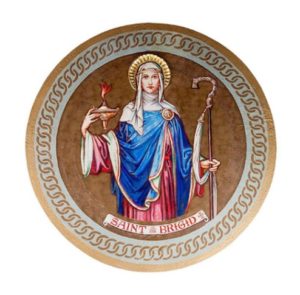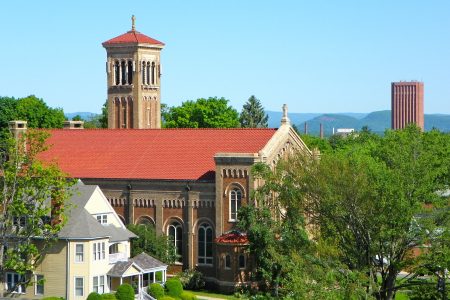


St. Brigid’s Parish Community
122 North Pleasant Street
Amherst, Massachusetts 01002
Tel: (413) -256-6181
saintbrigidsamherst@gmail.com
Mailing Address: 43 North Prospect Street, Amherst, MA 01002
Serving the communities of Amherst,
Leverett, North Amherst, Pelham,
Shutesbury, and South Amherst.
Administrator: Rev. Fr. Gary Dailey
Parochial Vicar: Rev Fr. Valentine Nworah
So far as is known the town of Amherst, incorporated in 1759, was first visited by a Catholic priest, Rev. James Fitton, in the early 1840’s.
Then for some years prior to 1860, the people had regular services from Rev. Jeremiah O’Callahan of Holyoke. He and his successor, Rev. James Sullivan, also of Holyoke, celebrated Mass in the home of John Slater, the first communicant of the Roman Catholic Church to settle in Amherst. Other Catholics had lived in Amherst, but he was the first to make the town his home.
For a few years, one small room was sufficient to accommodate the few people attending. From this private home, as numbers increased, Father Sullivan engaged a school house on Pleasant Street. Later the size of the group warranted the use of Palmer Hall.
The first settled pastor the church was Rev. Francis Brennan who came to Amherst from Holyoke in February 1872 and remained until July 1878, when failing health forced his retirement. For several years thereafter the church was conducted as a mission of the church in Northampton, with Rev. E. M. Barry in charge.
In 1887, Rev. John B. Drennan came to St. Bridget’s as a resident pastor. He purchased the house at the corner of Pleasant Street and Cowles Lane. This became the parochial residence. During the years the church and the rectory were widely separated, the McGrath family living next door were volunteer custodians of the church property. The Sunday-school connected with the church was organized in 1872. In 1870, the cemetery at Plainville, Hadley, called St. Bridget’s cemetery, was consecrated by Archbishop Williams.
In 1891, Rev. John G. Gavin succeeded Fr. Drennan. Fr. Drennan was transferred to Southbridge. Under Fr. Gavin’s influence the parish grew and became a great force for good, up and down the valley. Only 721 souls were within the confines of the parish which included Amherst, Hadley, North Hadley, Shutesbury, Pelham, Prescott and Leverett plus parts of Belchertown and Sunderland. There are yet a good number who remember his mode of transportation — horse and buggy. He is remembered as a very humble priest, a lover of souls, most understanding and charitable. In Fr. McCoy’s History of this area he is quoted as stating: “All has been peaceful as a meadow brook and at no time has religious life sung more softly in the years that fell to Fr. Gavin”.
In 1911 he was transferred to Blackstone and was succeeded by Rev. John J. Bell, a man of great dignity, a real scholar, an excellent organizer, esteemed by members of all faith. Soon he organized Church societies for men and women. Within a year after Fr. Bell’s arrival, Fr. Leo Goddard was appointed his assistant, followed next by the appointment of Fr. Julius Jaworek in 1913. By this time the parish numbered families of Polish, Lithuanian, French and Italian background as well as those of Irish extraction.
During Fr. Bell’s eight years, the need for a more spiritual relationship between the parish and the college students was recognized and hence Catholic college clubs were formed.
In 1919, Rev. John J. O’Malley succeeded Fr. Bell who was made pastor in Clinton. Very soon after his coming Fr. O’Malley purchased the residence of E. D. Bangs, President of the Amherst Savings Bank. This home eventually became the new rectory which stands today. Formulation of plans for a new church came about during his pastorate. The corner stone was laid in 1923 and dedicated September 27, 1925 by Rev. Thomas O’Leary, Bishop of Springfield. It measures 130 x 48 feet square and seats 600. Bishop O’Leary changed the name to St. Brigid’s, honoring the Irish saint whose feast is celebrated in February 1. She pioneered community life for women by establishing monasteries for nuns to live a community life, rather than separate individual style living at home, prevalent in the early fifth century.
Rev. Arthur Sheedy succeeded Fr. O’Malley in 1928, rallying parishioners to finding ways of decreasing the debt upon the church.
Rev. Patrick Madden became pastor in 1931 and served until his untimely death in 1934. He converted the barn that stood next to the Rectory into a hall with kitchen facilities, and a large room on the first floor plus sanitation facilities. On the second floor was a good sized meeting hall. The work was done by the men and women of the parish pooling their carpentry, painting and interior decorating talents under his guidance. It became known as Fr. Madden Hall. It has served for over thirty years the needs of the catecetical instructions, societies of the parish meetings and social gatherings.
Rev. Andrew Martin was assigned as pastor upon Fr. Madden’s death in 1934 and served the parish until 1939. The numbers of Catholics attending the colleges greatly increased the numbers at St. Brigid’s but the needs of all were met with patience, spiritual inspiration, sympathy, and compassion under his influence.
Upon Fr. Martin’s transfer to another pastorate, Fr. Patrick Coyle assumed the leadership of St. Brigid’s, in 1939. An unassuming, quiet, scholarly priest, his brilliance of mind was recognized by all. Death again claimed another untimely in 1942 after only three years.
From 1942, Fr. J. Alfred Lane, who succeeded Fr. Coyle as pastor has guided the parish to growth and progress. Twice the church has been redecorated, the last completed the early part of 1971. The marble alter has been moved to the center of the sanctuary to implement the new liturgy with due dignity and devotion. The baptistry moved from the front vestibule to the side of the sanctuary before our Blessed Mother’s altar. The entire church has been carpeted, with gold in gold in the sanctuary and a blue green in the main body. The Rectory has been enlarged and modernized, a new Parish Center has replaced the old barn with facilities for parish meetings, catecetical instructions, a library for reference, and auditorium second to none in its acoustics, seating over 500. The Parish Center’s beautiful Foyer greets its entrants in rich warm carpeting and furnishings. To care for the spiritual needs of its Catholic college students, a Newman Center was built on the University of Massachusetts campus and dedicated May 15, 1963. Msgr. David J. Power was named director and is assisted by Fr. J. Joseph Quigley. With deep spiritual depth, scholarly brilliance and firm guidance, Fr. Lane shepherded his flock well. He was elevated to the monsignorship in 1963 and served as Vicar Forane (V.F.) or Dean of Hampshire County, East.